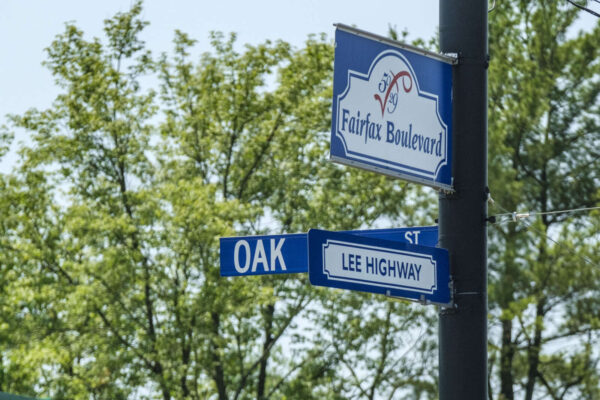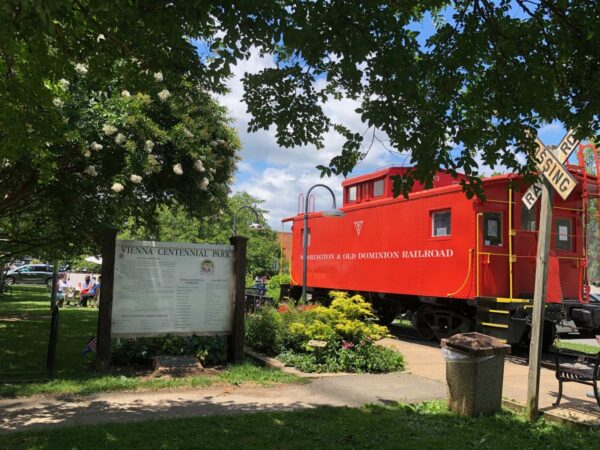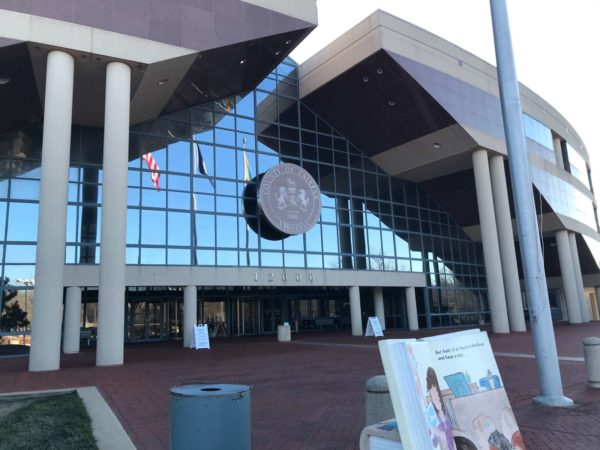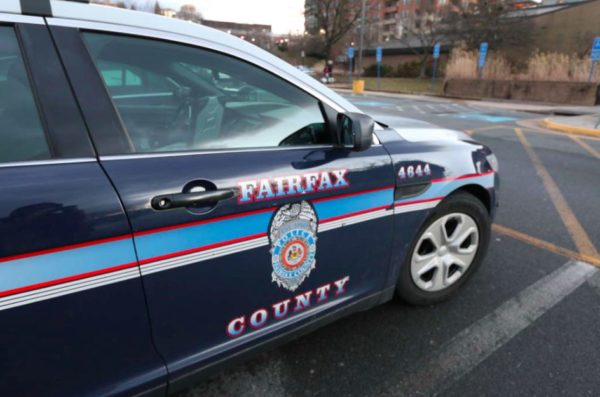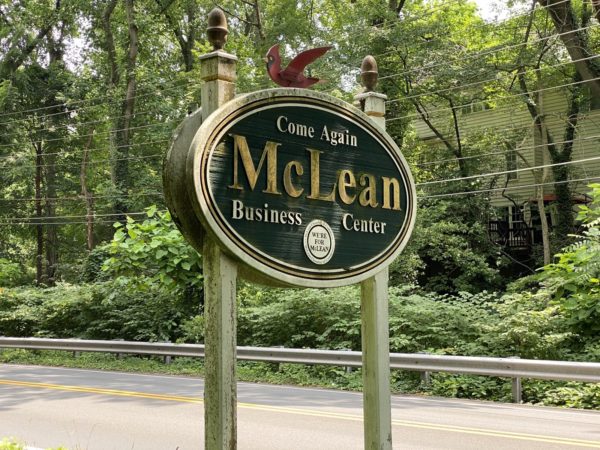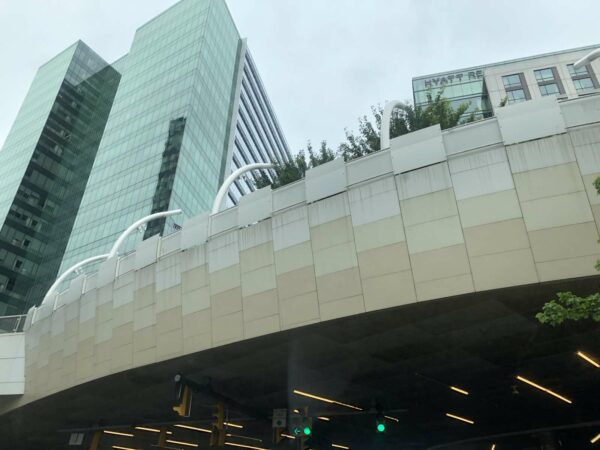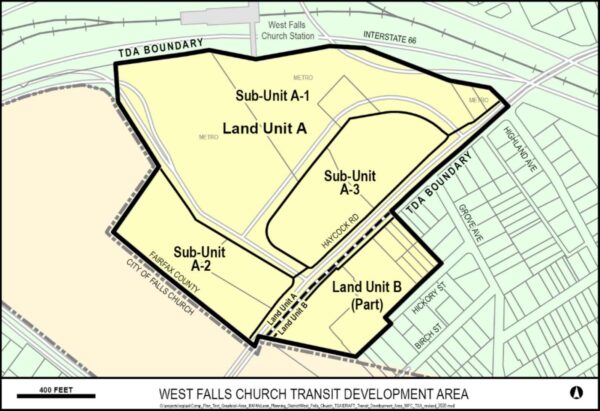
The Fairfax County Board of Supervisors unanimously approved amending the West Falls Church Transit Area Plan on Tuesday (July 13) to clear the road for future development near the Metro station.
The amendment opens up much of the nearby area to mixed-use development, with the aim of creating a residential and retail hub similar to the Mosaic District, but the approval came with some caveats from the county planning commission, and skepticism from some in the public.
Throughout the process, residents in nearby neighborhoods have shared concerns that the new developments will put more traffic onto nearby streets not build to withstand the pressure, particularly putting pedestrians in jeopardy even with some pedestrian improvements planned for the site.
The planning commission made some adjustments to the proposed amendment in recognition of these concerns, such as adding text saying that “connections should be provided within the site and to the existing pedestrian network surrounding the site, with an emphasis on pedestrian safety, accessibility, and comfort.”
At Tuesday’s public hearing, resident Adrienne Whyte said the amendment will allow developers to turn the site into a “gateway to gridlock” and that the suburban character of the nearby streets don’t support the kind of road network envisioned in the site plans.
“What other station depends on a two-lane country road for egress?” Whyte asked.
The project got some support from residents and various advocates, including Sonya Breehey, Northern Virginia coalition manager for the Coalition for Smarter Growth — an organization that Breehey acknowledged is partially funded by project developer EYA.
“The county must prioritize the redesign of its streets to make them safer for people walking and biking,” Breehey said. “Nearby streets need to be redesigned with bike lanes and safer crosswalks.”
Dranesville District Supervisor John Foust, who represents the area, celebrated the approval, but he acknowledged the ongoing community concerns and said he would support improvements down-the-road to nearby streets.
“Our work is not done,” Foust said. “Clearly there is concern…by neighborhoods that have challenges today. With or without this application, we need to address them.”
Board of Supervisors Chairman Jeff McKay said the project was adequately vetted and the area is appropriate for the planned development, but agreed with Foust that the nearby transportation problems can’t be ignored.
“Clearly, near a Metro station like this is where you want to see this type of growth,” McKay said. “That being said, residents have good reason to be concerned. We’ve got work left here to do.”

Fairfax County took a first step yesterday toward potentially taxing plastic bags used by grocery stores and other retailers.
The Board of Supervisors voted 9-1 yesterday (Tuesday) to direct county staff to draft an plastic bag tax ordinance, but even supporters of the measure allowed that there remains some uncertainty around how exactly the tax would be implemented if approved.
“Let’s definitely try this, but we may end up back in the General Assembly in the foreseeable future to try to get clarification,” Hunter Mill District Supervisor Walter Alcorn said, noting that the county is subject to the Dillon rule. “…This is probably a prime example of when we probably need a little more flexibility, but I’m all for it.”
The Virginia General Assembly passed legislation during its 2020 session giving localities the authority to impose a five-cent tax on disposable plastic bags, starting on Jan. 1, 2021.
Roanoke became the first jurisdiction to take advantage of the new law when it adopted an ordinance in May that’s set to take effect on Jan. 1, 2022.
Under House Bill 534, which was identical to Senate Bill 11, cities and counties can tax each disposable plastic bag provided to customers by grocery stores, convenience stores, and drugstores. The tax would not apply to plastic bags designed to be reused, garbage bags, bags used to hold or package food to avoid damage or contamination, and ones used to carry prescription drugs or dry cleaning.
The legislation allows retailers to retain two cents from the imposed tax on each bag until Jan. 1, 2023, when the amount that goes to retailers drops to one cent.
That “dealer discount” provision is intended to help offset additional expenses retailers might incur from adjusting their operations, but it also puts added pressure on localities to adopt an ordinance as soon as possible, according to Board of Supervisors Chairman Jeff McKay.
“We want to start the process of the ordinance review, looking at the language, the public input, because the clock literally is ticking,” McKay said.
Complicating matters is the fact that the Virginia Department of Taxation has not yet released guidelines clarifying what a plastic bag tax ordinance should look like, leaving questions around the definition of a grocery or convenience store, how the tax will be enforced, and other issues, County Executive Bryan Hill told the board in a Nov. 30 memorandum.
Braddock District Supervisor James Walkinshaw, who introduced the board matter on Tuesday, said the draft guidance that county staff has seen and provided input on through the Northern Virginia Regional Commission will clear up many of those questions.
He hopes the guidelines will be finalized soon so county staff can incorporate them into the ordinance that they have now been directed to draft and present to the board in September.
Springfield District Supervisor Pat Herrity, the lone Republican on the board, opposed the board matter, taking issue with the timing of the proposal. Read More
(Updated at 9:10 a.m. on 7/15/2021) Fairfax County is convening a “Confederate Names Task Force” specifically charged with making a recommendation about renaming the county’s portions of Lee Highway and Lee-Jackson Memorial Highway.
The Board of Supervisors approved the appointment of the 30-member task force on Tuesday (July 13).
The task force’s mission is to review the names of Lee Highway (Route 29) and Lee-Jackson Memorial Highway (Route 50) to determine if the roads should be renamed and, if so, what the names should be. A county-appointed facilitator will also work with the task force.
The roadways currently bear the monikers of Confederate generals Robert E. Lee and Thomas “Stonewall” Jackson.
This is a direct result of the work done by the county’s history commission to identify and inventory every place in the county named after a Confederate. The 539-page report noted that there were about 157 streets, parks, monuments, subdivisions, and public places in the county bearing names with ties to the Confederacy.
The most prominent were Lee Highway, about 14 miles of which runs through the county around Merrifield, Fairfax, and Centreville, and Lee-Jackson Memorial Highway. About 8.5 miles of that roadway runs through the county, including Chantilly and near Fair Oaks Mall.
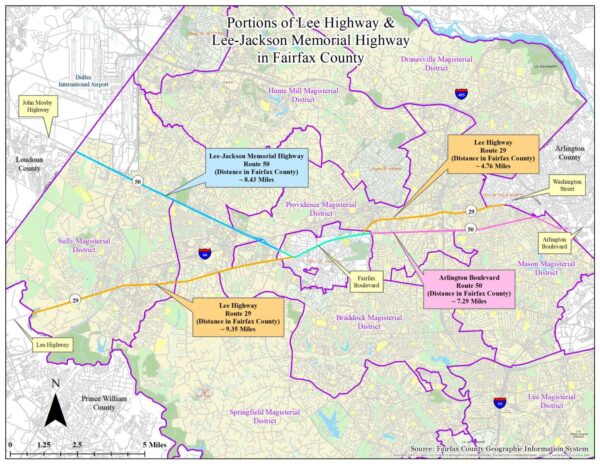
“In Fairfax County, our diversity is our greatest strength and it’s important that we honor and celebrate that diversity,” Board of Supervisors Chairman Jeff McKay said in the press release. “We cannot ignore what the Lee and Lee Jackson Memorial Highway names represent in our community and especially to our African American neighbors. The Confederate Names Task Force, which includes a diverse group, will examine and make recommendations on how both roadways can better reflect our values as we chart a positive path together for the future.”
The task force will meet monthly, starting later this month or early August, according to the agenda for the board meeting. The meetings will be open to the public, and the task force will seek input from the public prior to making a decision.
The group is expected to provide a recommendation to the county board by “the end of calendar year 2021.”
The task force is chaired by Sully District Planning Commissioner Evelyn Spain, who will be joined by 29 other members, including historians, civic organization leaders, homeowners’ association members, residents, professors, and faith leaders.
Spain says reevaluating the use of Confederate street and place names is necessary if Fairfax County wants to be inclusive and respectful of its increasingly diverse population.
“Naming highways after Robert E. Lee and Stonewall Jackson celebrates men who fought a war against the United States to perpetuate slavery,” Spain said in a statement. “One Fairfax requires us to look at these issues through an equity lens to understand how these names have negatively impacted our community and people of color as well as how Confederate names adversely impacts them today…I’m honored to be a part of the Confederate Names Task Force as we work toward building a more inclusive and equitable Fairfax County.”
If the task force recommends changing the names of the roads, the county will have to undergo a somewhat complicated process to actually make it happen — much like it was when Arlington renamed its portion of Route 29 and Alexandria renamed Route 1, which had been named after Confederate President Jefferson Davis.
If changes are recommended, the task force would need to provide two to five alternate names for each road. Then, the county board and task force will hold at least one public hearing to allow for comment about the potential change.
After the public hearings, the board will then vote on whether to take the task force’s recommendation. A timeline laid out back in May projected that could happen in early 2022.
If the board votes to change the highway names, it would then submit a resolution to the Commonwealth Transportation Board requesting the changes while also committing to paying for the signage.
If that’s approved by the Commonwealth, the board has to pass a budget item for the cost of the signs, and an interdepartmental working group would set up a timeline for the actual switching out of signs and, finally, officially changing the roads’ names.
The working group will also coordinate with other jurisdictions on their name changes.
County Commits to Carbon Neutrality by 2040 — The Fairfax County Board of Supervisors pledged yesterday (Tuesday) to make county government operations carbon-neutral by 2040 as part of a newly adopted Operational Energy Strategy. The move follows up on a recommendation issued by the county’s Joint Environmental Task Force last fall. [Fairfax County Government]
Virginia Named Best State for Business — CNBC named Virginia the number-one state for business in the U.S. for the fifth time, making it the only one to ever top consecutive rankings. CNBC, which didn’t release rankings last year due to the pandemic, highlighted the Commonwealth for its ability to recruit and retain talent. [Fairfax County Economic Development Authority]
Northrop Grumman to Test Moon Outpost — “NASA has finalized a $935 million contract with Falls Church, Virginia-based Northrop Grumman for a moon outpost living quarters for astronauts as part of its Artemis program, which will eventually return humans to the surface of the moon…NASA is currently targeting November 2024 to launch the spacecraft on a SpaceX rocket.” [WTOP]
Park Street in Vienna Closed for Utility Work — “Park Street SE will be closed to SE-bound traffic between the traffic circle and Cherry Street SE for water utility work tomorrow, July 14, from 9 p.m. until 5 a.m. Thursday, July 15. One-directional NW-bound traffic on Park Street SE will be open.” [Town of Vienna/Twitter]
Fairfax County will conduct a “comprehensive review” of the county’s response to the COVID-19 pandemic.
At today’s (July 13) Board of Supervisors meeting, Chairman Jeff McKay proposed as a board matter to have County Executive Bryan Hill review how county agencies responded to the challenges of the pandemic, how operations were affected, and how operational changes impacted the community.
The review will take place in two parts. The board directed staff to deliver a report with conclusions, recommendations, and areas of improvement in February 2022, and a follow-up is anticipated since the pandemic is still ongoing.
The motion passed unanimously.
“We did an amazing job [dealing with the pandemic],” McKay said, but he acknowledged that a review is needed since “there’s much to be learned about the county’s response and how we can improve upon that for the future.”
McKay also noted that a review is already essentially under way, but this formalizes the process and sets a deadline on it.
Hunter Mill District Supervisor Walter Alcorn agreed with the effort and asked the county executive not to pull any punches.
“I ask the county executive not to shy away from identifying challenges…[particularly] those in the labor market that were attributed to the pandemic and what happened after,” Alcorn said.
As noted in McKay’s comments, more than 75% of Fairfax Health District residents 18 years or older have received at least one vaccine shot. That’s above both national and state averages.
However, the county continues to face some challenges in convincing those who are still hesitant to get vaccinated.
When it comes to addressing COVID-19’s economic impact, the county has provided assistance with rent, food, and other basic needs to more than 10,000 households and helped get permanent housing for 400 individuals who were experiencing homelessness when the pandemic began, according to McKay’s board matter.
The county has also distributed more than $52 million in small business relief funding through the RISE program and is offering $25 million in their PIVOT program.
While half of the RISE grants went to minority-owned businesses, those businesses still suffered “acutely” during the pandemic. What’s more, the Northern Virginia Black Chamber of Commerce recently said it felt neglected in the development of some of the county’s grant programs.
McKay said that getting a comprehensive report on Fairfax County’s COVID-19 response will help the county government “ensure we maintain the level of service and functionality our community expects” in any future large-scale crisis or emergency.
A police use-of-force study commissioned by Fairfax County revealed that officers use force too often and more than should be expected against both Black and white civilians.
Findings and recommendations of the study conducted by researchers from the University of Texas at San Antonio were presented at the county’s Board of Supervisors public safety committee meeting yesterday (June 29).
The study dove into the 1,360 use-of-force cases involving the Fairfax County Police Department over a three-year period from January 2016 to December 2018.
About 42% of cases were directed at those who are Black, 38% to those who are white. Hispanic and Asian civilians comprised 16% and 3% of such cases, respectively.
Additionally, Black civilians were 1.8 times more likely to have a weapon, such as a taser or firearm, pointed at them by police.
Some of the findings surprised the researchers. For example, there was a higher level of use of force cases directed at those who are white than perhaps expected, and generally, police used force against Hispanic civilians less frequently than they predicted..
“It’s a little bit unusual to findings like that, in my experience,” said University of Texas professor Michael R. Smith, one of the researchers presenting the study. “But those are what they were here in Fairfax County.”
For Black people, who make up about 10.6% of Fairfax County’s population, force rates did exceed proportional rates in most categories — disparities that Smith noted were expected.
Some of the disparities can be tracked to specific district stations as well.
Force used against Black civilians happened at higher rates in the Mount Vernon District as well as in Franconia, McLean, and West Springfield.
Also, worth noting is that while use of force rates against Asian civilians, who now compose 20% of the county’s population, was overall lower across the county than other racial groups, it exceeded proportional benchmarks in Reston, Fair Oaks, West Springfield, and Mount Vernon.
Men are also much more likely to have more severe force used against them than women, which the researchers said was not uncommon.
A data point that roiled some county board members was if pointing a weapon (firearm or taser) constituted a Level 1 or more severe Level 3 use of force.
For the purposes of the study and after consulting with FCPD, researchers admitted they knocked down the severity of pointing a weapon, which altered the data.
“After some preliminary discussions with senior leadership of the police department, we re-coded the pointing of a weapon — typically a taser or a firearm — to a level one,” Smith said. “This showed…the disparity in force against African-Americans was largely [having to do with] the pointing of the weapon.”
The data revealed that Black civilians were close to nearly two times more likely to have a weapon pointed at them than white civilians.
“These coding decisions matter. It’s a conceptual question,” said Smith. “Police departments around the country and their communities are wrestling with this right now…How serious is it to point a weapon at someone?” Read More
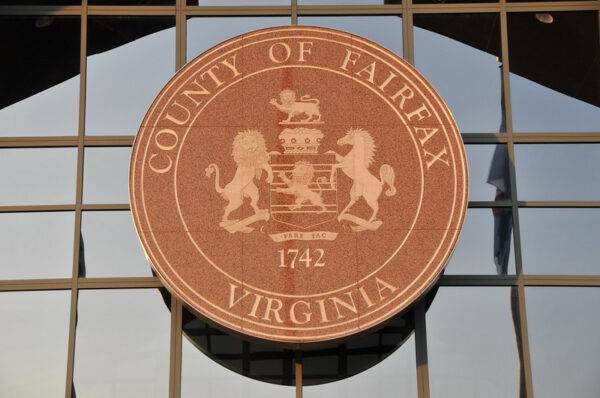
The Fairfax County Board of Supervisors is working its way toward letting public workers collectively bargain in the wake of a statewide change in 2020 to lift a decades-old restriction.
A board’s personnel committee met yesterday (Tuesday) to discuss a draft ordinance that would let Fairfax County workers make union contracts with the county government, giving them the power to negotiate pay and other benefits.
“I think we’re moving in a good direction,” Dranesville District Supervisor John Foust said after sharing concerns that the proposed ordinance might exempt too many employees from collective bargaining.
While managers, supervisors, volunteers, and other workers are slated to be excluded under the draft ordinance, the board is looking at where temporary workers such as summer lifeguards and seasonal park workers as well as non-merit employees should fall.
The proposed ordinance would serve as the framework for what can and can’t be done through collective bargaining. Once approved, it would allow workers to vote to form a bargaining unit, and employees who don’t want to be involved wouldn’t have to pay dues but could still receive the benefits of the change, Mason District Supervisor Penny Gross said.
The draft discussed Tuesday calls for collective bargaining agreements that would last three years or longer, with separate units for general government employees, police, and fire and emergency services. It also bans strikes and spells out numerous other issues.
The county’s ordinance would be separate from Fairfax County Public Schools, which has over 24,000 employees.
Gross, who chairs the personnel and reorganization committee that’s overseeing the development of the draft, said she expects the board will pass an ordinance, which could happen this year.
SEIU Virginia 512, a union that already includes over 2,000 members in Fairfax County from dues-paying maintenance workers and nurses to librarians and social workers, welcomed the board’s overall support.
But union president David Broder says the ordinance still falls short in several areas. Namely, he says it “artificially narrows” the scope of bargaining, excludes working conditions among the topics that can be negotiated, and could potentially leave thousands of workers out of the collective bargaining process.
“We’ve learned during the pandemic…that being able to bargain over working conditions is critical,” Broder said, noting the importance of safe and clean work sites, personal protective equipment availability, and scheduling.
Lee District Supervisor Rodney Lusk shared concerns about working conditions for public works and sanitation workers, expressing support for change.
Collective bargaining agreements could involve some 10,000 workers, Gross told Tysons Reporter, and the board is gathering more information on non-merit employees to help with its determinations.
“We have one opportunity to get this right, which is why we’re taking a little extra time to work on the ordinance,” Gross said.
In 1977, the Supreme Court of Virginia ruled that public-sector collective bargaining agreements weren’t permitted and existing ones were invalid, noting the state legislature could change that.
The General Assembly and governor approved legislation last year that gave localities the authority to develop ordinances for recognizing labor unions and permitting collective bargaining. That measure took effect on May 1.
The personnel committee will meet again on July 20, and the board expects to have a public hearing in October.
Photo via Machvee/Flickr
A long public process that started with one of Tysons Reporter’s very first stories ended Tuesday night (June 22) when the Fairfax County Board of Supervisors unanimously approved a plan intended to revitalize McLean’s stagnant downtown.
The Community Business Center plan breaks McLean into certain areas where greater density will be allowed in exchange for certain public amenities, with the density gradually decreasing from that new epicenter out towards the existing neighborhoods.
The passage wasn’t without controversy, with prominent community groups like the McLean Citizens Association (MCA) continuing to oppose the plan.
“The MCA opposes the new comprehensive plan because of certain major deficiencies,” MCA representative Scott Spitzer said at Tuesday’s public hearing.
The MCA’s opposition to the plan focused on a few particular issues, like concerns about losing surface parking in favor of a push toward underground or on-street parking. The MCA also sought to have more language in the plan that would guarantee certain above-roof features.
Other speakers at the meeting were more general in their opposition.
“The Mclean CBC vision plan being discussed here today is awful,” said Dennis Findley, a McLean resident and an architect. “It’s just awful…It’s developer-incentivized talking points. It’s a nightmare dystopian vision for my beloved community.”
There was some back-and-forth between Dranesville District Supervisor John Foust and Paul Kohlenberger, president of the Greater McLean Chamber of Commerce. Kohlenberger said his opposition to the plan as drafted was shared by every other McLean community-wide organization, though Foust later pushed back against that claim.
“We, like the others, have broadly supported the plan amendment process and support the aims of the process, and so does the broader community, but significant changes have been made since the task force stopped meeting in December,” Kohlenberger said. “Significant changes have undermined the plans ability to deliver the key benefits: multimodal connectivity, central gathering spaces, housing diversity, and stormwater management.”
In a tense exchange, Foust accused Kohlenberger of misrepresenting the views of other community organizations, stating that different groups have expressed different, sometimes incompatible demands.
“Everything you want is exactly what the organizations that have testified up to this point have said they don’t want,” Foust said. “You are on the outer limits…This is the reason it was so hard to get consensus.”
Other local residents expressed a concern that the McLean CBC plan would turn McLean into a new Tysons, saying they wanted to preserve the community’s “suburban character.”
Foust disputed that fear, saying that the proposed plan will provide more incentive for redevelopment in McLean than the existing comprehensive plan, which currently doesn’t allow enough development to justify the associated costs, but not to the extent allowed in Tysons.
“For many years, I’ve heard from residents who want a more pedestrian-friendly, vibrant downtown where we can celebrate a sense of place, where McLean residents can gather and celebrate community-focused events,” Foust said. “…We are not creating another Tysons. I believe this plan addresses each of the concerns and accommodates the goals set forth by the community.”
Ultimately, Foust led the Board in approval of the project.
“There’s strong interest in both directions,” Foust said. “We tried to find a middle and I think we did. There’s lots of misinformation out there…I think we have an excellent plan. It’s what the community wants, and not necessarily what certain organizations and individuals want. [But] doing nothing in McLean is not an option. Either we revitalize the business district or we continue to deteriorate and provide fewer and fewer community amenities. We see it year after year.”
The rest of the Board of Supervisors asked no questions and made no further comment on the plan. Chair Jeff McKay said he shared Foust’s sentiments regarding the necessity of the plan for McLean’s future.
“Often times we want the amenities, but folks don’t want any impacts, and ultimately we know that’s not possible,” McKay said. “So, we have to craft a plan that tries to balance the issues of revitalization with some real concerns from the community and when you do that, there’s often disagreement over how far one went at the expense of the other. The idea of doing nothing isn’t really acceptable.”
McLean Downtown Plan Public Hearing Today — The Fairfax County Board of Supervisors will hold a public hearing at 4:30 p.m. today (Tuesday) on the McLean Community Business Center plan, which unanimously passed the planning commission earlier this month. The plan aims to revitalize McLean’s downtown area but has faced objections over parking, building heights, and the potential impact on local schools. [Fairfax County Government]
Capital One Center Starbucks Closed — The Starbucks at Capital One Center (1610 Capital One Drive North) is temporarily closed “due to limited office occupancy during the COVID pandemic,” a spokesperson for the development confirmed to Tysons Reporter, adding that the coffee shop is expected to reopen “in the near future.” [Capital One Center]
Madeira School Expansion Approved — “Fairfax County supervisors on June 8 voted 10-0 to grant a special exception allowing Madeira School to add a new science building, more faculty housing and improved equestrian facilities on its McLean campus…Under the newly approved plan, Madeira will have 518,255 square feet of gross floor area, with up to 45 residential units and up to 12 accessory-dwelling units.” [Sun Gazette]
McLean HS Turf Field Replacement Starts Today — “Starting tomorrow (June 22nd), the turf field and track at our stadium will be closed until early August. This shut down is due to our turf field being replaced. We apologize for inconvenience.” [McLean High School]
Wolf Trap to Salute Front-Line Workers — “Wolf Trap is officially back open for in-person shows after a year of pandemic closures. So what better way to celebrate than a series of ‘Thank You Community Concerts,’ saluting frontline workers, education workers and health care workers?” [WTOP]

With federal money that gives low-income households a discount on internet service set to run out this year, Fairfax County leaders and staff are looking at ways to ensure people get access to broadband internet, which they’ve likened to a utility like electricity or water.
A staff report presented to the Fairfax County Board of Supervisors’ information technology committee on Tuesday (June 15) found that there are significant disparities in internet access among homes in the county due to infrastructure and affordability.
While different county representatives — from the school system to the Department of Family Services — were collaborating prior to the COVID-19 pandemic, they started looking more intently at equity issues during the pandemic, as technology needs hit a crescendo between students attending school from home and job seekers looking for work.
“Many of us saw at the outset how difficult it was for community members to work from home or for their children to be educated from home — whether or not they had the technology available, if they had strong enough internet connectivity, if they had space in their own homes to do this, or if they were trying to locate wireless within the community and do all of this from their own cars,” Fairfax County Public Library Director Jessica Hudson said.
Some zip codes are more affected by this lack of connectivity than others.
According to an analysis presented by the county, an estimated 4.2% of households in the county have no broadband internet access, but that number jumps up to 20.8% in the zip code 22044 and 18.8% in zip code 22041, both neighborhoods in the Seven Corners area of Falls Church.
The county estimates that 10.7% of households in north Reston (zip code 20190) are without broadband internet, along with 6.2% of Herndon residents (zip code 20170).
The gaps in connectivity are concentrated in areas with many people of color and lower-income households, Fairfax County Chief Equity Officer Karla Bruce said on Tuesday.
The Federal Communications Commission internet discount, known as the Emergency Broadband Benefit or EBB, helps lower-income households get a $50 discount each month for broadband service, among other benefits.
Officials are continuing to share information about the program, providing outreach in multiple languages and partnering with nonprofits and other community organizations.
You can still get the discount even if you have another benefit called Lifeline, which provides a $9.25 monthly discount indefinitely, Hudson said.
But the $3.2 billion fund set up to provide the EBB benefits nationwide is expected to run out this year, possibly around Thanksgiving, according to Hudson.
Among the county’s efforts to improve access, the library system offers Chromebooks that people can check out for two weeks at a time, along with extended exterior WiFi access outside buildings (except in parking garages) from 6 a.m. to 10 p.m.
In addition, Neighborhood and Community Services is conducting a countywide analysis of Wi-Fi access, and the Department of Housing and Community Development and Redevelopment and Housing Authority are conducting a site analysis to address connectivity barriers, according to the county presentation.
“All of these community agencies are trying their hardest to find ways to connect with residents and make sure that they have appropriate technology, digital literacy skills, and access points,” Hudson said.
County supervisors asked for more information to target areas in need as part of the county’s efforts to help overcome access issues.
Photo via Josefa nDiaz/Unsplash


